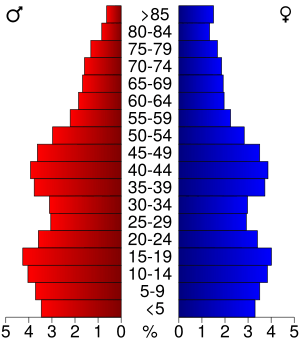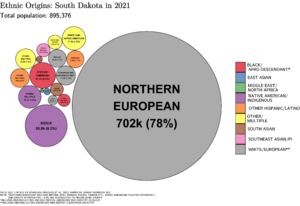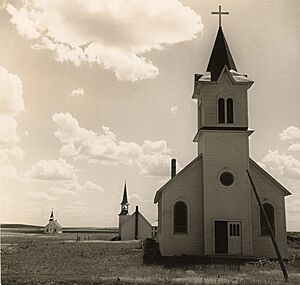Demographics of South Dakota facts for kids
South Dakota is a state in the United States with a population of about 884,659 people as of 2019. Most people living in South Dakota are White, and the main religion is Christianity. In 2010, almost everyone (93.46%) spoke English as their main language.
Contents
Population in South Dakota
In 2012, South Dakota had about 833,354 people. This was a small increase from 2010. About half of the population (49.8%) were female. In 2011, a small part of the population (2.4%) was born in other countries. Also, there were over 71,000 veterans living in the state that year.
The very center of South Dakota's population is in Buffalo County, in a small place called Gann Valley.
How South Dakota's Population Has Changed
| Historical population | |||
|---|---|---|---|
| Census | Pop. | %± | |
| 1860 | 4,837 | — | |
| 1870 | 11,776 | 143.5% | |
| 1880 | 98,268 | 734.5% | |
| 1890 | 348,600 | 254.7% | |
| 1900 | 401,570 | 15.2% | |
| 1910 | 583,888 | 45.4% | |
| 1920 | 636,547 | 9.0% | |
| 1930 | 692,849 | 8.8% | |
| 1940 | 642,961 | −7.2% | |
| 1950 | 652,740 | 1.5% | |
| 1960 | 680,514 | 4.3% | |
| 1970 | 665,507 | −2.2% | |
| 1980 | 690,768 | 3.8% | |
| 1990 | 696,004 | 0.8% | |
| 2000 | 754,844 | 8.5% | |
| 2010 | 814,180 | 7.9% | |
| 2020 | 886,667 | 8.9% | |
| Sources: 1910–2020 | |||
South Dakota, like some nearby states, has seen a trend called "rural flight." This means that people are moving away from smaller towns and rural areas. Many towns in these states have fewer than 3,000 people. Between 1996 and 2004, almost half a million people left these six states. Many of them had college degrees.
To try and get people to move to rural areas, some places offer free land or tax breaks. However, not all parts of South Dakota have lost people. Areas like Sioux Falls and the Black Hills have actually grown. For example, Lincoln County, near Sioux Falls, is one of the fastest-growing counties in the U.S. This growth helps balance out the population loss in other parts of the state. Overall, South Dakota's population continues to grow, just not as fast as the national average.
How Old Are People in South Dakota?
In South Dakota, about 7.3% of the population is under 5 years old. About 24.5% are under 18. And 14.7% of people are 65 years old or older.
In 2010, the average age of people in South Dakota was 36.9 years old.
Where Do People Live?
The largest city area in South Dakota is the Sioux Falls metropolitan area. This area includes Lincoln, McCook, Minnehaha, and Turner counties. Its main city is Sioux Falls. In 2010, about 228,261 people lived there.
The second largest city area is the Rapid City metropolitan area. In 2009, about 124,766 people lived there. This area includes Pennington and Meade counties, with Rapid City as its main city.
Top 10 Most Populated Counties in 2019
The county with the most people in South Dakota is Minnehaha County, with about 193,134 residents. The county with the fewest people is Jones County, with only about 903 people.
Here are the top 10 most populated counties in South Dakota:
| County | Main City | Estimated Population |
|---|---|---|
| Minnehaha | Sioux Falls | 193,134 |
| Pennington | Rapid City | 113,775 |
| Lincoln | Canton | 61,128 |
| Brown | Aberdeen | 38,839 |
| Brookings | Brookings | 35,007 |
| Meade | Sturgis | 28,332 |
| Codington | Watertown | 28,009 |
| Lawrence | Deadwood | 25,844 |
| Yankton | Yankton | 22,814 |
| Davison | Mitchell | 19,775 |
Who Lives in South Dakota? (Ethnicity)

In 2012, most people in South Dakota (86.2%) were White. About 8.9% were American Indian or Alaskan Native. Other groups included Hispanic or Latino (3.1%), Black or African American (1.7%), and Asian (1.1%). Some people (2.1%) also identified as belonging to more than one race.
Many South Dakotans have German heritage, making up about 42.8% of the population. Other common backgrounds include Norwegian, Irish, English, and Dutch. German-Americans are the largest group in most parts of the state, especially in the east.
South Dakota is home to the largest population of Hutterites in the U.S. Hutterites are a group who live in communities and came from Europe in 1874. Many Hutterite families returned to South Dakota after moving to Canada for a time. Today, there are about 35 Hutterite communities in the state.
Native Americans, mostly from the Lakota, Dakota, and Nakota (Sioux) tribes, live in several counties. South Dakota has the third-highest percentage of Native Americans of any state. Some counties are entirely within Indian reservations. People living on reservations sometimes face challenges, but efforts are being made to improve living conditions.
| By race | White | Black | AIAN* | Asian | NHPI* |
|---|---|---|---|---|---|
| 2000 (total population) | 90.36% | 0.90% | 9.06% | 0.80% | 0.07% |
| 2000 (Hispanic only) | 1.21% | 0.04% | 0.24% | 0.02% | 0.01% |
| 2005 (total population) | 89.64% | 1.17% | 9.43% | 0.92% | 0.06% |
| 2005 (Hispanic only) | 1.83% | 0.07% | 0.23% | 0.02% | 0.00% |
| Growth 2000–05 (total population) | 1.98% | 33.36% | 7.02% | 17.99% | -9.87% |
| Growth 2000–05 (non-Hispanic only) | 1.25% | 31.10% | 7.20% | 18.58% | -5.69% |
| Growth 2000–05 (Hispanic only) | 55.60% | 78.64% | 0.17% | -6.21% | -41.54% |
| * AIAN is American Indian or Alaskan Native; NHPI is Native Hawaiian or Pacific Islander | |||||
What Languages Are Spoken?
| Language | Percentage of population (as of 2010) |
|---|---|
| Spanish | 2.06% |
| Dakota | 1.39% |
| German | 1.37% |
| Vietnamese | 0.16% |
| Chinese (including Cantonese and Mandarin) | 0.12% |
| Russian | 0.10% |
| Amharic and French (tied) | 0.09% |
| Other American Indian and Serbo-Croatian (tied) | 0.08% |
| Tagalog | 0.06% |
| Czech and Korean (tied) | 0.05% |
As of 2010, most people in South Dakota (93.46%) spoke English as their main language. However, about 6.54% of the population spoke a language other than English. The most common non-English languages were Spanish (2.06%), Dakota (1.39%), and German (1.37%).
Since 2019, the language of the Great Sioux Nation, which includes the Dakota, Lakota, and Nakota dialects, is an official language in South Dakota. This is a big step in recognizing and preserving these important Native American languages.
Between 2000 and 2010, Spanish became the most common non-English language spoken in South Dakota, taking the place of German. Dakota also became more common than German. The total number of people speaking non-English languages slightly increased during this time.
What About Religion?
Most people in South Dakota who follow a religion are Christians. In 2010, the largest group was Mainline Protestants. Catholicism was the second largest, followed by Evangelical Protestantism.
The Catholic Church had the most members in South Dakota in 2010, with over 148,000 people. The Evangelical Lutheran Church in America was also very popular, with over 112,000 followers. The United Methodist Church had about 36,000 members.
A survey in 2001 showed that 86% of South Dakotans said they were Christian. About 8% said they were not religious, and 3% followed a non-Christian religion. The largest Christian groups were Lutheran (27%) and Roman Catholic (25%). Other Christian groups included Methodist, Baptist, and Presbyterian.





